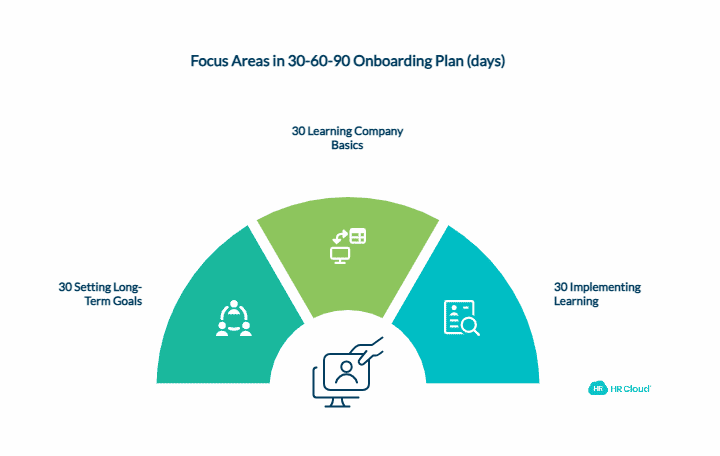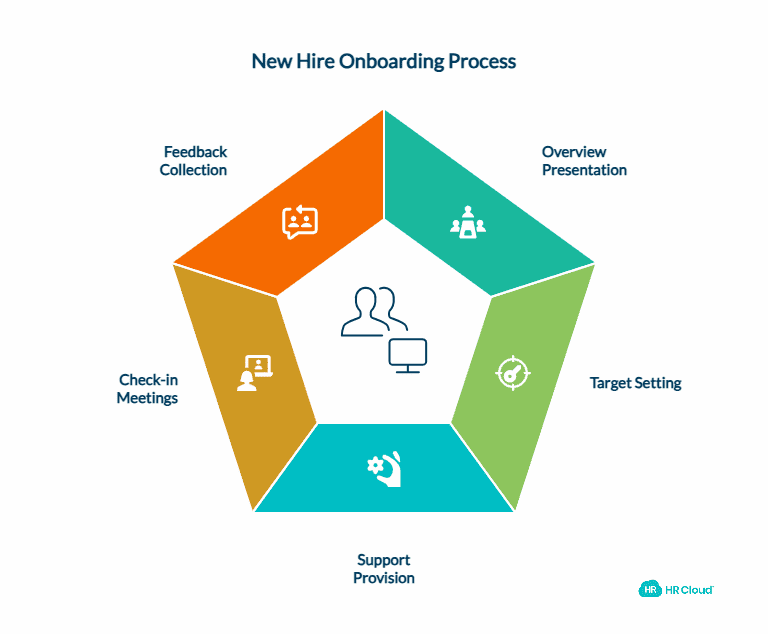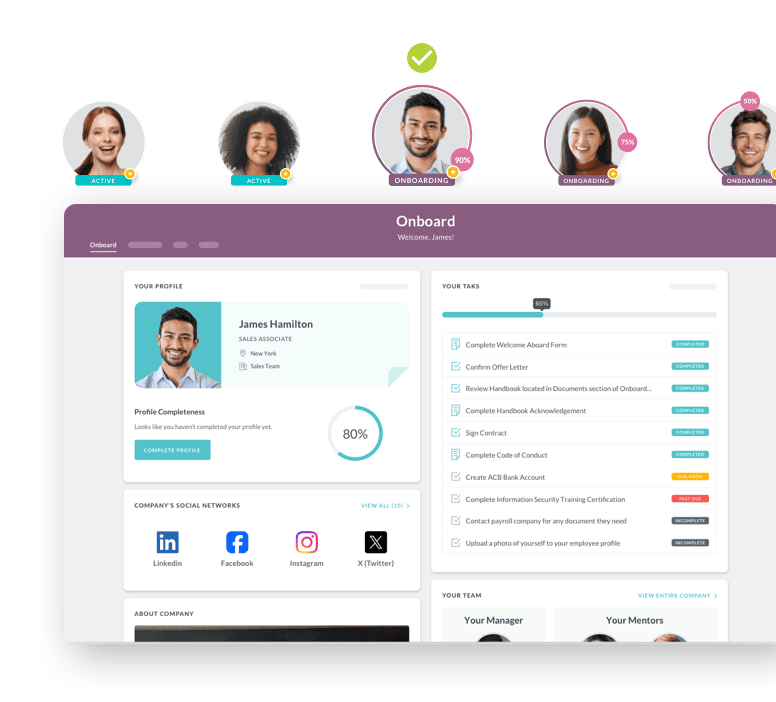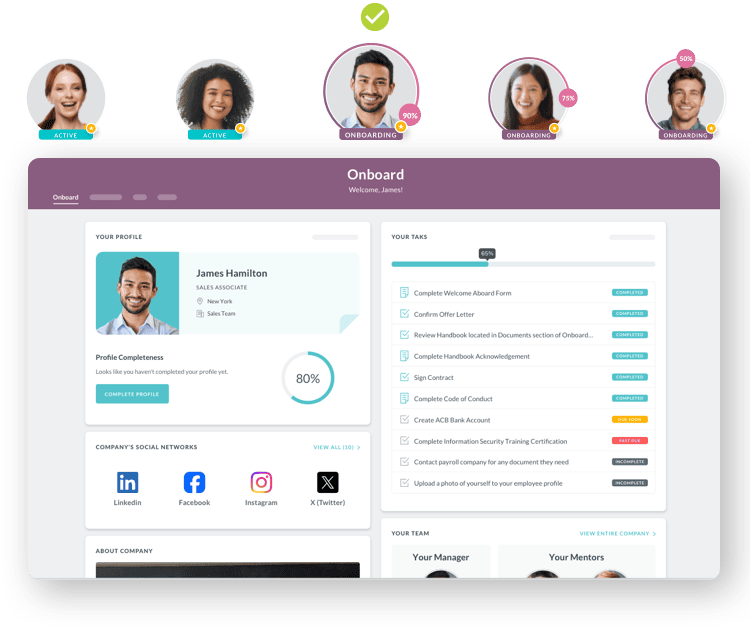The 30 60 90 Onboarding Plan: How to Gradually Guide Your New Hires
.png)


 Cut onboarding time
by 60%—here's the
Ultimate Checklist
that helped do it.
Cut onboarding time
by 60%—here's the
Ultimate Checklist
that helped do it.

The first impression your employees get of your business and how it works is through the new hire onboarding process. Although they may have met your hiring team or members of your human resources department during the talent acquisition and hiring process, it's during onboarding that new hires set the foundations for a strong work ethic and approach. Getting your onboarding programs right can integrate new hires into the team seamlessly, boosting employee engagement and helping them find job satisfaction.
Each new hire adapts to your business differently, yet there are common onboarding goals and targets that everyone needs to meet to take on their new role. These are often thrown at new hires immediately, expecting them to understand online phone systems, team hierarchies, and project software in a few weeks. However, for the onboarding experience to be a positive one for everyone, staggering these goals with a 30-60-90-day plan may be more effective for the successful onboarding of new hires.
What is a 30 60 90 Onboarding Plan?
As a strategy for helping your business to effectively and efficiently guide new hires into their roles, the 30-60-90 plan breaks it down into manageable sections. These sections set targets for the first 30 days, 60 days, and 90 days of a new hire's employment with your business, helping them to engage with your onboarding without overwhelming them.
The 30 60 90 method helps new hires to understand the basics and initiate training elements and learning that may take longer. Highlighting different focuses for the first 90 days can be useful for both new hires and those overseeing the onboarding process. Doing this removes the pressure for new hires to understand everything instantly. Instead, they concentrate on:
-
Day 1-30: learning about the company culture, organizational structure, company policies, and what their job responsibilities are within it.
-
Day 31-60: implementing their learning and taking on tasks according to their position.
-
Day 61-90: setting longer-term goals and becoming a reliable part of their team.
How to Use 30-60-90 to Guide Your New Hires
Give an Overview
In the first few days of your new hire's employment, schedule time to give them an overview of the onboarding process. This ensures everyone's on the same page from the start and sets expectations of what needs to be covered over the coming months. Your overview should focus on how the 30-60-90 plan works as well as a general background of the company and its work environment. Consider using an onboarding checklist to ensure all crucial points are covered during this new employee welcome.
Make sure you choose the most effective way to give your overview. A phone call may prove to be limited if you plan on using visual aids. A video call with a screen-sharing option would be a better option and allow you to provide an overview to a number of users at the same time.
During this time, work with the new hire to establish a reasonable workload and introduce them to your project management software to help them oversee their onboarding. You don't want to overload them with responsibilities and tasks, so it's better to underestimate their capabilities. If necessary, you can add more responsibilities and tasks to their workload over time if they can handle it.
Schedule regular catch-ups using a VoIP phone system to make sure your new hires feel comfortable and not overwhelmed by their new responsibilities. You could even send text messages as a quick way to check in as long as you have their permission and it's within work hours.
If you use multiple communication channels in the workplace, you may need to talk them through what is CPaaS platform and how you use it internally. New hires may find using different forms of communication overwhelming, and you want to ensure as smooth as possible a transition.
Set Targets
The 30-60-90 day plan is built around goal setting at a reasonable and achievable rate. You may have general targets for the onboarding period; however, ensure you also make specific targets too, using the SMART goals method to dictate a timescale and how you measure achievements. What type of targets you set depends on the stage of the onboarding process the new hire is in.


30-day Targets
Targets for the first month of employment should center on learning and acquiring knowledge. This could be through training programs and online courses, as well as ensuring new hires know where to ask questions in the future. Your new hire won't acquire all the knowledge they need for their position within the first month, so the 30-day targets can be ongoing.
In this period, your new hire's targets should cover getting to grips with the organizational structure of your business alongside its values. Particularly if you use recruitment automation for hiring so the new employee hasn't met many people in your business, this is essential for making introductions and highlighting what people are responsible for. From here, the new hire's targets can move on to learning about your products, how to set up caller ID on their desk phone and mobile devices, and the responsibilities of their role. This is also a good time to introduce them to the employee handbook and other essential resources.
If they will be using their personal mobile phones for work, consider moving their number onto your business phone service provider. You will be able to check phone number portability before, and this way, they won't be charged for any work-related activity. It can be a nice perk to offer new hires too.
60-day Targets
Your 60-day targets focus on integrating new hires with their team and taking on the responsibilities of their position. Therefore, these targets are going to be more task-based and set the groundwork for how they work with the rest of the team. This starts to form work habits and routines, so new hires need to get them right and address any issues early on.
Some of the crucial 60-day targets need to include setting up regular one-to-ones and meetings, identifying ways of addressing issues with the team, and discussing what feedback is most useful to them. Other practical targets may include using call software functions from your hosted PBX provider, using your email finder, and meeting deadlines for tasks or projects. These enable the new hire to work effectively in their team and contribute to workforce development and team collaboration.
90-day Targets
During the third month of your new hire's onboarding, they should be used to their role and able to set long-term goals. The focus should be on managing their responsibilities effectively and ensuring their quality of work meets your business standards. These help your new hire become a valuable team member, matching the accuracy and consistency of their colleagues.
Targets for the 90 days can, again, be ongoing, setting expectations of the level of work the new hire can complete in their workday. For example, the targets set an amount of sales conversions the new hire wants to reach or use performance metrics to measure their productivity and efficiency within the team. These may be similar to other employees' targets, based on the feedback of their manager and aligned with key performance indicators. This is also a good time to introduce performance goals and discuss career development opportunities.
Provide Support
You should support all your employees in various ways; however, for new hires, this support needs to be even more evident. Whether they have questions about where to find specific documents for a client like a release of liability template or a vendor agreement, want to shadow someone running a project, or need encouragement as they take on new tasks, your teams need to be on hand to help. Not everyone has to be constantly available, but the new hire should know where to find support.
One way of supporting new hires is by assigning them a buddy - someone from within their team to answer questions and show them how things work. During the first 30 days, this buddy may reduce their workload with the help of productivity tools to dedicate time to the new hire. Over time, the buddy will gradually return to their work routine, although still looking out for the new hire when possible. This approach can significantly improve employee retention and satisfaction, contributing to overall employee development.
Check-in
As the 30-60-90 plan centers around target setting at a steady pace, it's important to check in on these targets and see how the new hire is hitting them. Reflecting on the new hire's experience so far provides an opportunity to encourage them, track how much information they remember during onboarding, as well as plan their route forward for professional development and skill development.
Whilst checking in with your new hire, you may need to adjust some targets. This could be because they aren't achieving what you initially anticipated. Slowing their onboarding or focusing on one part of the role can help the new hire become familiar at a more gradual pace. Alternatively, the new hire may beat their targets, needing more challenging goals to be created.
If you choose to check in using your small business phone system consider using call recording. This way your new hires can listen back and review their targets before each meeting. Just make sure your call quality is good enough for them to do this. These check-ins can also serve as informal performance reviews, helping to prepare the new hire for future performance evaluations.
Collect Feedback
If you want to keep improving your onboarding and refining your 30-60-90 day template, having feedback can direct your attention. Asking new hires who've just gone through the onboarding process about their experience and what could be improved can emphasize where the plan is unclear or useful additional resources. This feedback could also be generally about the business, such as ensuring your unified communications as a service software connects remote workers to the network too.
Asking for feedback can also make your new hires feel like a part of the team. Rather than feedback being one-way comments on how the new hire can improve and adjust to their role, receiving their feedback acknowledges that team integration is a group responsibility. It also shows that your business values the opinions of its employees, acting on their feedback to enhance employee relations and overall talent management. Regular feedback sessions can contribute significantly to employee satisfaction and growth.
Gradually Guide Your New Hires With the 30 60 90 Method
We've all been the new hire at some point and onboarding has such an impact on the rest of your experience with a business. The information you learn and the people you meet can shape a new hire's perception of a company as well as influence their new work routines. Rather than making joining a new business an overwhelming experience, gradually guiding new hires into their roles can create a more seamless and positive transition for everyone involved.
Introducing the 30-60-90 day plan to your business doesn't necessarily disregard your previous onboarding strategies. Instead, it acts as a way of pacing the information and tasks you load onto your new hire, giving them time to adjust and become familiar with them. This can work alongside employee handbooks, training schemes, and other onboarding tools to build an informative and engaging program, whilst helping your new hires to avoid burnout and fostering a positive work environment.
 Discover how our HR solutions streamline onboarding, boost employee engagement, and simplify HR management
Discover how our HR solutions streamline onboarding, boost employee engagement, and simplify HR management
Author Bio
John Allen is a driven marketing professional with over 14 years of experience, an extensive background in building and optimizing digital marketing programs across SEM, SEO, paid media, mobile, social, and email, with an eye to new customer acquisition and increasing revenue
Keep Reading
AI for Frontline HR: Moving Beyond Sentiment Analysis to Build Tomorrow's Workforce Management Engine
TL;DR: While most organizations limit artificial intelligence in human resources to basic
How to Onboard Nurses and Clinical Staff Without Burning Out Your HR Team
Healthcare HR teams spend up to 57% of their time on administrative tasks, and onboarding
The Definitive Guide to Onboarding Field & Clinical Staff in Healthcare (2026)
Key findings covered in this guide:
The turnover crisis: 58% of nurses report burnout
Like What You Hear?
We'd love to chat with you more about how HR Cloud® can support your business's HR needs. Book Your Free Demo

Build a Culture of Recognition. Boost Engagement. Guaranteed.
Workmates empowers employees to stay informed, connected, and appreciated—whether they’re on the front line, in the office, or remote. Recognition drives 12x higher engagement.Trusted by industry leaders in every sector




Cut Onboarding Costs by 60%.
Take the confusion and follow-ups out of onboarding with automated workflows, digital forms, and structured portals—so new hires ramp faster 3X quicker.Trusted by industry leaders in every sector




